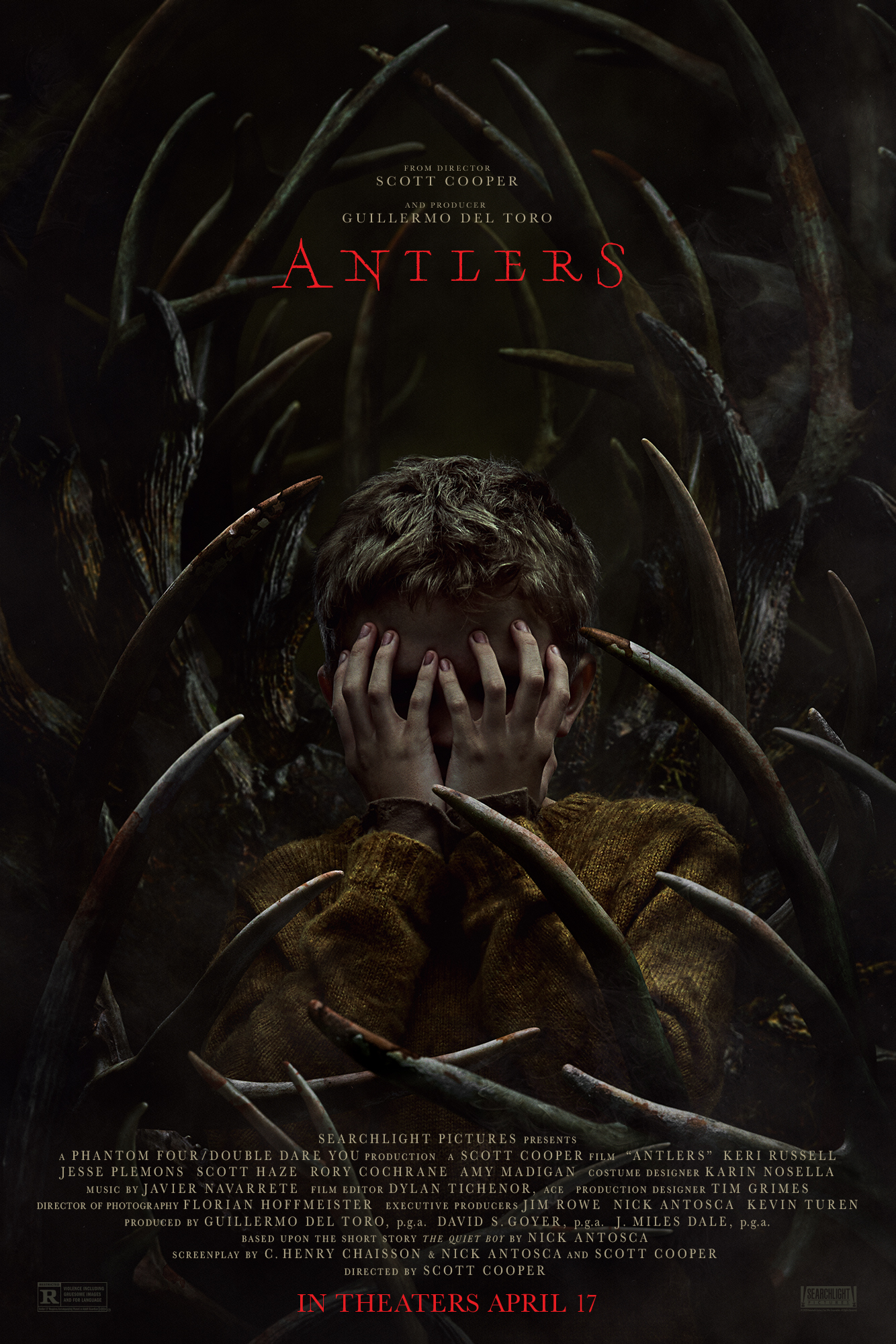Now Playing
Current DJ: K-Tel
Bush Tetras Too Many Creeps from Very, Very Happy (ROIR) Add to Collection
Requests? 773-DJ-SONGS or .(JavaScript must be enabled to view this email address)
by Kyle Sanders
 Antlers (Dir. Scott Cooper)
Antlers (Dir. Scott Cooper)
"Doh! A dud, a real bad dud..."
Behind every horror film there's a message, and that message is usually about something bad we humans have done.
Whether it's the human error of hubris (think Frankenstein, Godzilla, The Human Centipede), facing our violent pasts (Candyman, The Devil's Backbone, The Grudge), a rejection of American Values (The Night of the Living Dead, The Texas Chainsaw Massacre) or punishment for premarital relations (pretty much any slasher flick from the '80s), horror films seem to be mankind's response to a guilty conscience: we've done something bad, and we must pay for it one way or another, preferably in the most fucked up way imaginable.
Before the dawn of horror films however, we had myths, which typically served as an explanation for the unexplainable. If there is no other reasonable resolution, then the answer must be due to some vengeful spirit from beyond the grave or a reclusive monster lurking deep in the woods, right?
The Wendigo, a mythical creature in the new horror film Antlers, is both spirit and monster, a deer-like being that's destructive and cannibalistic, whose origins are based in the northern forests of Nova Scotia, the East Coast of Canada, and Great Lakes Region of Canada.
The Wendigo's presence in Antlers makes plenty of sense as the film takes place in a small coastal town in Oregon, where it attacks and terrorizes a meth-dealing father (Scott Haze) and his two young boys (Jeremy T. Thomas and Sawyer Jones).
The trauma this creature causes hangs heavy on the oldest boy's shoulders, and it's not long before his teacher (Keri Russell) becomes embroiled with his situation, getting her sheriff brother (Jesse Plemons) involved when she suspects the problem is beyond the boy's control.
Little does she know, the problem is well beyond normal comprehension (annnnnnnd that's where the myth part comes in!).
Based on a short story by co-screenwriter Nick Antosca, the film's storyline feels muddled, lost in the foggy mists of the Pacific Northwest. As rich as the Wendigo's mythic background is, the film can't seem to flesh it out.
It's suggested that perhaps this once prosperous place now deteriorating thanks to the likes of an opioid crisis and mountain-top removal could be the cause for such a malevolent creature to appear and feed off the negative energy produced by its inhabitants, but the plot is too distracted by other less-intriguing backstories of its main characters.
Russell's character seems preoccupied enough dealing with her own trauma, coping with an abusive childhood that is briefly hinted at in dialogue and past memories that blend with her present, but the effect is confusing and not entirely effective.
Her character's sympathetic connection to the boy is left mostly on the surface, with both losing their mothers at a young age. While she has her own inner demons to face, he is literally dealing with one--having possessed the body of his father--yet neither scenario pulls the emotional punch the film is straining for.
When the Wendigo is finally revealed in its true form, the film is already halfway over, and its presence has barely registered before we get to the underwhelming showdown.
The creature itself is pretty horrific. A sight of grisly antlers and lanky claws (by way of one of the film's producers, monster maestro Guillermo Del Toro) that leaves behind corpses that are viscerally horrifying to look at: husks of protruding bones and tissue.
Yet there are very few moments that offer a full view of its ferocious form once it breaks out of the boy's father. In what could've been a really cool moment, the monster peels off the face of its host from its own, but it's a moment lost to the background of the scene, a wasted opportunity that could've amped up some much needed horror.
Speaking of, Scott Cooper's direction of scares is middling at best. The dilapidated setting of a town that's seen better days is effective enough to set the mood, but the film relies on cheap thrills and jump scares at the expense of its supporting (and rather expendable) cast.
Solid actors like Amy Madigan and Rory Cochrane somehow convincingly portray naive characters doomed to hear "DON'T GO IN THERE!" shouted at the screen on repeated viewings. By the film's anticlimactic end, there's a rather unsubtle setup for a sequel, but it'll prove most difficult to find any fresh perspective from this horror film that's already used up typical scare tactics saved for lesser installments.
Overall, Antlers is a subpar horror film filled with sincere performances and a genuinely crafted (albeit dimly lit) monster. Despite its moody setting and frightful effects, Antlers sharpens unnecessary tension at unintentional moments, leaving what should be its real scares rather dull.
Next entry: Take Two: “I Want Candy” (The Strangeloves Vs. Bow Wow Wow)
Previous entry: Take Two: “The Safety Dance” (Men Without Hats vs. Angel Olsen)